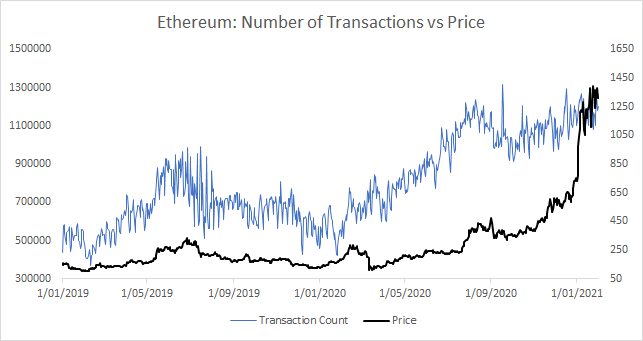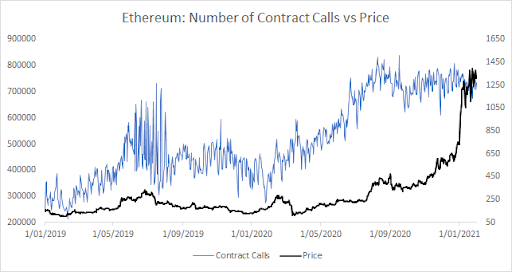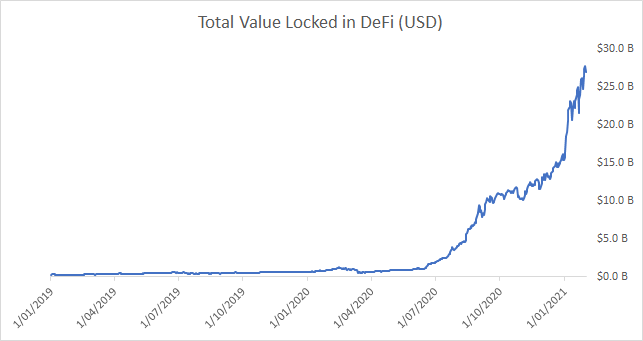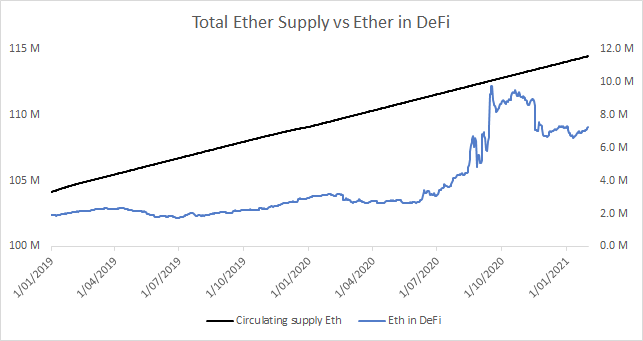Content
- Commodities
- Demand side
- Ethereum usage statistics vs price
- Use cases for the Ethereum network
- DeFi
- Growing use cases
- Tokenisation of traditional assets
- Ethereum supply chains
- Traceability and transparency
- Smart contracts and payments in supply chains
- Healthcare
- Gaming and entertainment
- Others, e.g. digital identity
- Private blockchains vs Ethereum
- Competitors
- Supply side
- Supply, EIP 1559 and ETH 2.0
- Why now: Ethereum Supply Crunch
- Conclusion: Ethereum as the internet of finance
- About Us
26 Feb, 21
Why Ethereum is Superior: The Triple Point Asset

- Commodities
- Demand side
- Ethereum usage statistics vs price
- Use cases for the Ethereum network
- DeFi
- Growing use cases
- Tokenisation of traditional assets
- Ethereum supply chains
- Traceability and transparency
- Smart contracts and payments in supply chains
- Healthcare
- Gaming and entertainment
- Others, e.g. digital identity
- Private blockchains vs Ethereum
- Competitors
- Supply side
- Supply, EIP 1559 and ETH 2.0
- Why now: Ethereum Supply Crunch
- Conclusion: Ethereum as the internet of finance
- About Us
In our Ethereum Primer, we outlined the platform’s underlying technology and functionalities, such as the ability to facilitate the global exchange of assets without an intermediary. But the question is: how do we quantify the value that Ethereum provides and how does this translate to ethereum’s value as an investable asset? There are few traditional financial models, such as discounted cash flow, that will effectively value Ethereum, but we can analyse the factors that affect the supply and demand economics of Ethereum. This article will be exploring ether’s value as a triple point asset; a commodity, yield-bearing capital asset and store of value. Credits to Bankless for this term.
Originally published on Capitalist Exploits on February 25th, 2021
Commodities
Commodities such as rice, oil, gold or palladium, are used as inputs of production for other goods or services. Using wheat to make bread, oil to produce fuel, and palladium to create cars defines them as commodities. They are the raw materials needed to create something. On the Ethereum network, the Ethereum asset (ETH) is the raw material required to produce value on the platform. Any time a person wants to act on the Ethereum network, he would have to pay a “gas” fee. Gas is denominated in ether, and can be thought of as a payment to power the network like the gas required to power a car. To use Ethereum’s DeFi applications, smart contracts or information processing, gas will be required. A regular user would have to buy and reserve a small amount of Ethereum for his current and future transactions. Simultaneously, the use of Ethereum on an enterprise level requires a treasury strategy to hold reserves for transaction fees, similar to airlines reserving and buying forward contracts on fuel.
The total amount of transaction fees paid by Ethereum users from 2020 is shown below.
Demand side
Ethereum usage statistics vs price
Ethereum usage drives price as ETH is used to pay for transaction fees. The first chart below shows the number of active addresses versus ETH price. Think of active addresses as bank accounts that are making transactions on Ethereum. The second chart shows the number of transactions made on Ethereum. The third chart shows the number of transactions interacting with smart contracts on Ethereum.


Use cases for the Ethereum network
The use cases of Ethereum drive these transactions. If you have not already, we recommend reading our Ethereum Primer and Overview of DeFi article to understand the Ethereum network. We will briefly outline the underlying technology here:
- Globalised peer-to-peer network allows exchange of value through financial and non-financial assets without intermediaries such as banks, brokers, and marketplaces.
- Smart contracts facilitate and automate transactions of any asset, eliminating the need for intermediaries, such as lending money.
- Financial applications being built on Ethereum, such as decentralised banking systems, exchanges, loaning platforms, asset management platforms, derivatives, marketplaces and even insurance.
- Ethereum breaks down localised and global borders, creating one platform for all types of transactions.
- Being a globalised platform means that liquidity on the platform is provided and accessible by everyone worldwide.
- Ethereum’s blockchain is a public ledger store on a decentralised network of computers, meaning a total record of transactions is untameable and always accessible.
Specific use cases are elaborated on below.
DeFi
DeFi has become the defining use case for Ethereum. The ability to transact safely, quickly and cheaply around the globe 24/7 is something that traditional financial institutions do not offer. Problems such as banks charging $30 fees for each simple overseas wire transfer, large FX bid/ask spreads offered to consumers, only being able to trade securities during stock exchange operating hours, should not exist in the digital era of the 21st century. Read our DeFi article for an overview of the space.
There has been a surge of capital into DeFi protocols in 2020, as they allow users to gain yield on their assets by providing capital on lending platforms or exchanges. Total value locked into DeFi has grown from $300 million on 01/01/2019, to $27 billion on 31/1/2021.


Growing use cases
Tokenisation of traditional assets
There is a growing amount of assets being tokenised onto the Ethereum blockchain for more efficient client onboarding and transaction processing, aiming to increase access to wider pools of investors.
€350M of real estate assets tokenised by Mata Capital.
$100M worth of shares of four real estate funds tokenised by Harbor.
€100M bond tokenised by Societe General.
$40M bond tokenised by Cadence.
$20M bond tokenised by Santander.
$78M worth of gold tokenised by PAXG.
DBS is working on offering tokenised securities and assets.
The tokenisation of these assets are fairly recent, dating between 2019 – 2020. With the size of global debt being $253 trillion and real estate at $280 trillion, the current value of tokenised assets is a drop in the ocean compared to the total addressable market. We believe the number of tokenised assets will heavily increase in the future, driving an increase in transactions and adoption for the Ethereum network.
Ethereum supply chains
Traceability and transparency
There is an increasing need for the traceability and transparency of goods such as produce, diamonds, watches and even wine. Putting supply chain information onto the blockchain, where everyone can see and identify information, brings radical transparency. Problems such as bacteria outbreaks in produce such as lettuce are more common than they should be, which has led to devastating consequences. To reach a customer’s hands, the lettuce has to go through a farm, a processing plant, a delivery service, wholesale distribution centre, and then finally to the retail store. Coupled with the fact that there are multiple farms and multiple lettuce batches, it would be a challenging task to identify which particular batch is associated with an outbreak. Integrating an information system with blockchain technology allows instant identification of a compromised set. This means that instead of having to destroy all lettuce, negatively impacting the livelihood of many farmers, retail stores can dump particular batches.
Luxury products, such as watches and wine, suffer from counterfeiting and grey markets. It is difficult for regular customers to identify if they are purchasing a fake Rolex or counterfeit wine. By tagging a unique ethereum based token to each watch or bottle of wine and tracking it from supply, manufacturing, and purchase, retailers and customers can easily verify the authenticity of the product.
Smart contracts and payments in supply chains
Smart Contracts could be used to automate payments whenever certain conditions are met. A simple example involves a bank, a supplier and a buyer. First, the buyer uploads their order onto the blockchain, where both the bank and supplier can verify. The bank then knows the supplier has business to lend working capital to the supplier to acquire materials and manufacture goods. When the buyer receives the product, he pays the Smart Contract, which will automatically remit funds to the bank and supplier. This lowers the bank’s default risk, allowing it to either allow loans with lower rates or give out more loans in general. The supplier also does not have to manually process paperwork to remit funds to the bank or do reconciliation after, which increases administrative efficiency.
Ernst and Young announced their supply chain procurement solution built on Ethereum.
Healthcare
Information blocking has plagued the healthcare industry in countries such as America and Australia, where most healthcare institutions operate in a somewhat siloed manner. Electronic health records of patients are not shared between healthcare institutions because it is cumbersome to do so without compromising data integrity, privacy laws, and profits. The main issue is stemming from a lack of an interoperable and standardised electronic health record system. America’s information blocking rule will go into effect in April 2021, but standardised API functionality will not be required until December 2022. This rule has also led to concerns for patient privacy and viability for certain healthcare providers. The use of a blockchain in this scenario would enable patients’ records to be securely accessed by healthcare providers, which saves cost and can provide help in time-sensitive situations.
Gaming and entertainment
Games built on Ethereum create radical ownership opportunities, where players can own in-game assets on the Ethereum blockchain. Popular games such as Hearthstone, Pokemon Go, Fortnite, League of Legends ban the selling or buying of in-game items through their terms of service.
Games on Ethereum like Godsunchained are attempting to disrupt this industry by issuing digital tokens representing in-game assets onto the network. Godsunchained is a trading card game, where players can either buy or earn cards, which are then minted onto the Ethereum blockchain and tradeable with anyone. Their first card set sale raised 6.2 million USD, while they received $15 million USD in venture capital funding. However, current adoption for such games are not high and remains to be seen if this young sector will prove itself.
Others, e.g. digital identity
Blockchains benefit information and data flow. Imagine that you had a digital identity encrypted onto Ethereum. Your credit history, medical health records, passport and licenses, would be wholly owned by you, and easily shared and validated with your permission. Instead of waiting two weeks for your home loan to process because of background and credit checks, it could be processed instantly by banks or other lenders. Administration costs are eliminated due to the efficiency and security of the blockchain. Listing all the use cases of this Ethereum would overwhelm this document, just think of all the inefficiencies in information processing and trade, and if blockchains can solve it.
Apart from DeFi and the tokenisation of assets, the other use cases for Ethereum are nascent. However, the release of EY’s Baseline Protocol, which is catered for enterprise-level users, has made Ethereum the leading public blockchain solution for business and supply chain integration. We see great potential for growth in these areas for years to come.
Private blockchains vs Ethereum
Not all these use cases need to be performed on the Ethereum network. Private blockchains allow for more control, and can be faster and less expensive than public networks like Ethereum. However, the key differentiator here is control. Suppose you have an entire network of external companies that interact with each other via the blockchain. Would they be willing to use a private blockchain where one entity can control all records input onto the blockchain? It is also much easier to attack the data centres of a private blockchain than Ethereum’s globalised network of validators.
A note on ledger transparency, the privacy of transactions on private blockchains and public blockchains should not be confused. Information on private blockchains can be restricted to anyone in an ecosystem, and the same holds true for public blockchains. Sensitive information can be synchronised between relevant parties only, as EY’s Baseline Protocol on Ethereum has enabled.
Competitors
You might ask, “Can’t another business just replicate this and steal market share?” Since Ethereum is an open-source platform anyone can instantly copy and execute their own version of Ethereum at any time. But so far, no one has been successful in their attempt. One of the most interesting phenomena of the 21st century is the network effect. Anyone could create their version of Facebook, Instagram, Whatsapp, Reddit, Twitter, etc. People have tried, and failed. Why? Because it is the users that give these platforms the value it has. Metcalfe’s law states that a network’s value is proportional to the square of the number of connected users in the system. For example, a single eBay user is useless by itself, but have a million users on it and you get one of the best marketplaces in the world. In the same vein, Ethereum and Bitcoin have the highest number of developers and users in the cryptocurrency industry by far, including large organisations like EY that are building enterprise-level solutions on Ethereum.
The number of users and stakeholders on a blockchain also contributes to its security and decentralisation. Smaller blockchains such as Bitcoin Gold and Ethereum Classic, which are different versions of Bitcoin and Ethereum’s code, had security compromised when malicious attackers could double-spend their balances. These smaller chains are much easier to attack as lesser stakeholders are securing the network.
Supply side
Supply, EIP 1559 and ETH 2.0
Currently, the security of Ethereum is secured via proof-of-work, meaning that miners are paid to validate and secure the network through the use of computing power. There is a minimum necessary issuance of ethereum to reward these miners, ensuring the network’s security. In addition to the issuance that miners earn, they also receive the Gas fees from users that transact on the Ethereum network. Currently, the minimum issuance translates to a 4.5% annual inflation of Ethereum supply.
When Ethereum moves to phase 1.5 of version 2.0, projected in late 2021 or early 2022, proof-of-work will be replaced by proof-of-stake; the security of the network will be secured by validators with aligned financial incentives, reducing the minimum necessary issuance of ether. Ethereum has launched phase 0 of version 2.0, meaning you can stake your ethereum to earn yield, making it a yield-generating capital asset.
EIP 1559 is another Ethereum upgrade proposal pending onto the system. It introduces a base fee to be burnt every time a user acts on the network. This burns ethereum instead of distributing to miners, which ultimately reduces inflation. Implementing these upgrades is estimated to reduce Ether’s inflation rate to near 0, with a possibility of negative inflation if EIP1559 results in large amounts of burnt fees.
Projected issuance of ethereum by Attestant:
- Phase 0 of Ethereum 2.0
- Implementation of EIP-1559
- Phase 1.5 of Ethereum 2.0
- Phase 2 of Ethereum 2.0
As of 31/1/2021, the deposit contract of Eth 2.0 has received 2,890,594 ether, approximately 2.5% of the total supply. This growing amount of staked ethereum is estimated to be locked away from the circulating supply for 1-2 years, as the withdrawal function of the contract has not been implemented.
Why now: Ethereum Supply Crunch
The launch of phase 0 of Eth 2.0 was a success. At phase 1.5, Eth 2.0 is projected to drastically reduce its current inflation rate of 4.5% per year, ranging between 0.17% to 2% per year. These numbers do not include projected burned ethereu, from EIP-1559.
Grayscale’s Ethereum Trust balance grew from 47k ETH in 2018, to 497k in 2019, to 2.94m as of 31/1/2021, representing 2.57% of the total supply of ether.
This increasing scarcity of ETH combined with the growing demand and use cases of the Ethereum network is transforming it into a store of value.
We see Ethereum as the future of finance and ethereum as an asset will only become more precious as days pass. DeFi has attracted and is attracting more capital, cementing Ethereum’s position as the borderless internet of finance. Ethereum is now settling over $20 billion worth of transactions a day in just ETH and stablecoin volume, which is higher than Paypal’s reported numbers.
Conclusion: Ethereum as the internet of finance
The year of 2020 has brought significant changes to the Ethereum ecosystem. Ernst and Young released the Baseline Protocol in March for corporations to utilise the Ethereum blockchain. The surge of capital into DeFi from June has been a key driver in ETH demand. Eth 2.0 launching marks the start of the growing scarcity of ether.
As a whole, the cryptocurrency space has received institutional and retail attention. On the institutional side, publicly traded companies such as Microstrategy, Galaxy and Square hold Bitcoin in their treasuries. On the retail side, Paypal announced that their US users can buy, sell and hold Bitcoin, Ethereum, Bitcoin Cash and Litecoin now, and use them to make purchases in 2021. As traditional markets flock to Bitcoin as digital gold – a hedge, soon they will notice the existence of Ethereum, the internet of finance and ethereum is superior as its triple point asset.
About Us
Zerocap provides digital asset investment and custodial services to forward-thinking investors and institutions globally. Our investment team and Wealth Platform offer frictionless access to digital assets with industry-leading security. To learn more, contact the team at hello@zerocap.com or visit our website www.zerocap.com
Like this article? Share
Latest Insights
Weekly Crypto Market Wrap: 28th July 2025
Zerocap is a market-leading digital asset firm, providing trading, liquidity and custody to forward-thinking institutions and investors globally. To learn more, contact the team at
Weekly Crypto Market Wrap: 21st July 2025
Zerocap is a market-leading digital asset firm, providing trading, liquidity and custody to forward-thinking institutions and investors globally. To learn more, contact the team at
Weekly Crypto Market Wrap: 14th July 2025
Zerocap is a market-leading digital asset firm, providing trading, liquidity and custody to forward-thinking institutions and investors globally. To learn more, contact the team at
Receive Our Insights
Subscribe to receive our publications in newsletter format — the best way to stay informed about crypto asset market trends and topics.



 Share
Share  Tweet
Tweet  Post
Post 